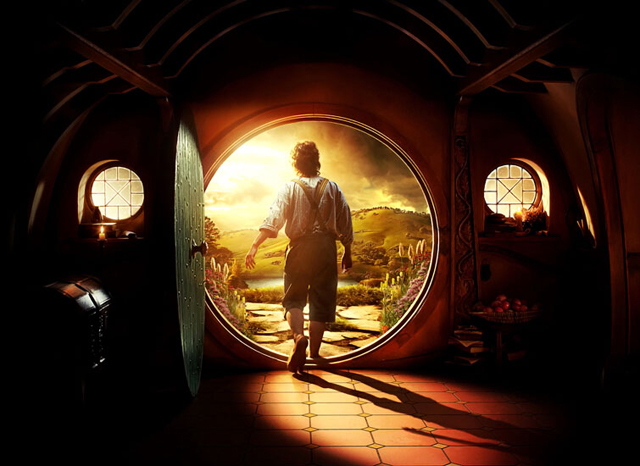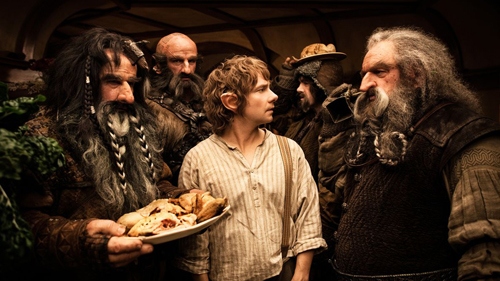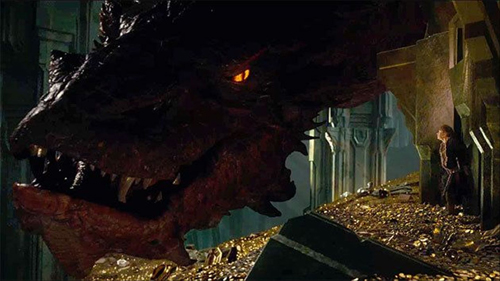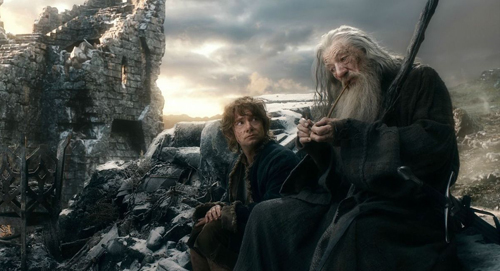
From the moment the credits rolled on The Lord of the Rings: The Return of the King (2003), the entire Middle Earth fandom began to chatter all at once, “When are we getting The Hobbit.” It’s understandable that the demand would immediately be there for more adventures on the big screen within this world from the creative mind of J.R.R. Tolkein. Director Peter Jackson’s adaptation of Tolkein’s trilogy did an amazing job of making the immense world of Middle Earth feel real and immerisve, and it was a world that audiences were very much in favor of revisiting. Thankfully, Tolkein had given his world plenty of extra lore to draw from. In fact, The Lord of the Rings itself was a literary successor to Tolkein’s first ever published novel, The Hobbit. First hitting bookshelves in 1937, The Hobbit became an instant hit in what was considered “children’s literature,” and it would become a highly influential book in the history of 20th century fantasy writing. Tolkein was of course pressed upon by his publisher to write a sequel, and Tolkein would spend the next 20 years developing the three volumes that make Rings. Though The Lord of the Rings is still considered to be J.R.R. Tolkein’s magnum opus, The Hobbit is still a treasured story in it’s own that thankfully has thrived outside of Ring’s shadow. In 1977 in fact, The Hobbit was the first Middle Earth story to receive a cinematic treatment, with the Rankin Bass produced animated feature, long before The Lord of the Rings would ever get it’s own film treatment, despite many attempts. It is interesting, however, that so many filmmakers bypassed The Hobbit so many times in favor of the Lord of the Rings. It’s understandable, Rings is the grander story, but at the same time it’s also built upon the foundation laid for it by The Hobbit. One can’t begin the story without addressing the events that came before in The Hobbit. Even Peter Jackson’s movie trilogy calls back to events in The Hobbit, which of course didn’t exist as a movie yet. So, once the Rings trilogy was complete, it’s only natural that long time fans would want to have The Hobbit adapted too as a way of completing the saga, even if it meant going backwards. However, getting there was easier said than done.
Of course, fans wanted to see Peter Jackson return as a director for The Hobbit, but after devoting five tiring years of his life to this one production, it was very understandable that Jackson initially chose to step aside and let someone else take charge. He instead chose to stay involved as a producer, but before any movement could be made on the project, a long rights battle behind the scenes had to be resolved. One point of contention was the feud between Peter Jackson and New Line Cinema over the profits made on the Rings trilogy. I wrote more at length about it in my breakdown of the failed launch of The Golden Compass here, and suffice to say New Line brought about their own downfall over the situation, as parent company Warner Brothers took charge and resolved the matter themselves, effectively diminishing New Line’s independence in the process. At the same time, Warner Brothers had to deal with the fact that while they held the rights to The Lord of the Rings, the rights to The Hobbit belonged to MGM, who had made the Rankin Bass feature years ago and still firm ownership, given that they received the rights from Tolkein himself. Knowing the value that they held, MGM were keen to make sure that Warner Brothers were not going to short change them if they sought to get the rights from them, This became a long, protracted battle that took many years to resolve, with some fans worrying that this studio war over this valuable IP could make it impossible for The Hobbit to ever be made; especially in the way they wanted it, as a companion to Jackson’s trilogy. Eventually, a deal was cut and The Hobbit could finally move forward as a WB/MGM co-production. Meanwhile, Jackson and his team were working hard to make up for lost time. As a replacement in the director’s chair, Jackson found an ideal candidate in Mexican auteur Guillermo Del Toro, who shares many of the same cinematic qualities as Jackson does. Alongside returning co-writers Fran Walsh and Phillipa Boyens, Jackson and Del Toro worked out a script for a two film adaptation of The Hobbit. The casting also began in earnest, with the team managing to secure returning cast from Lord of the Rings like Ian McKellan, Cate Blanchett, Hugo Weaving, Orlando Bloom, and even then 90 year old Christopher Lee. The production team, also made up of Rings alum also got to work in earnest. However, the long delays due studio driven turmoil would eventually become too much, and Guillermo sadly had to step aside. In order to keep this troubled project from falling further apart, Peter Jackson reluctantly stepped back into the role of director, hoping to guide this massive project to the finish line. And, in 2012, a decade after the The Lord of the Rings made it’s debut, audiences finally made their return to middle earth. Looking at each film now, we see an interesting examples of all the rights and wrongs that can happen in trying to pick up where one massive success began.

THE HOBBIT: AN UNEXPECTED JOURNEY (2012)
Even with The Lord of the Rings being as wildly successful as it was, there’s still a lot of pressure to setting the tone right in the beginning of another story within this world. It becomes even more treacherous when the audience is already aware where the story is ultimately headed, as Rings preceded this as a film adaptation. At the start of the first film, An Unexpected Journey, Peter Jackson does deliver a bit of fanservice and table setting, with a prologue narrated by Ian Holm, who played Bilbo Baggins in Lord of the Rings. For good measure, we also get to see Elijah Wood return as Frodo, as it becomes clear that the prologue takes place mere moments before The Lord of the Rings begins. But, once that scene does it’s job, and the opening title has been cast upon the screen, then Jackson returns the movie to where it needs to be, ripped right from the text of the book. We flash back 70 years to Bilbo in his younger days, and it’s here that the the movie establishes what it needs to be; that it is firmly Bilbo Baggins’ story. For the adaptation of The Hobbit to work, there had to be a lot of pressure in finding the right actor to play Bilbo Baggins. Thankfully, they found him in beloved British character actor Martin Freeman. Freeman, best known at that point for his comedic work in shows like The Office, was certainly a popular choice for the part, and he perfectly fit into the mold of what was needed for the character of Bilbo. Building upon what Ian Holm already brought to the character, Freeman really imbues Bilbo with an everyman likability; quirky, but relatable, and capable of balancing screwball comedic timing with heartfelt pathos without losing any integrity in the performance. It’s an especially strong performance that arguably is even better than any we’ve seen before in The Lord of the Rings, and it’s even more remarkable that he’s able to shine so much in this movie, given how busy and jam packed it is.
Not only do we get the story of Bilbo Baggins, but also that of his 13 Dwarf companions. One of the best aspects of The Hobbit is that it focuses so much on the people and culture of the dwarf race of Middle Earth, something that The Lord of the Rings barely touches upon with only Gimli there to represent it. Peter Jackson manages to expertly balance each of the different dwarves personalities, helping to distinguish them from one another. But, despite creating entertaining characters, there’s also needs of the story to lay out in this first chapter, and this is the point where some find fault with Peter Jackson’s Hobbit. The original book is 350 pages long, which is very slim compared to the 1400 page behemoth that is Lord of the Rings. For Peter Jackson, he was under pressure to make The Hobbit feel as grand as Rings, but the source material by it’s very nature is much more modest. So, to satisfy the need for a bigger story, Jackson included other elements from Middle Earth lore to build up the story much more than what was originally on the page. That way he could get the film to a bulkier six hour run-time spread over two films. However, the downside of that leads to a film that feels more bloated and languid than what we saw in The Lord of the Rings. Pacing is a problem, with some scenes long over staying their welcome, and side tracks in the story that feel more laborious than they should. The extended section of the movie in Goblin Town and a side track to Rivendell in particular feels a lot less magical than they should have been. However, when the movie needs to focus on the moments that should be the highlights of the whole story, it doesn’t let down. Chief among them is the Riddles in the Dark segment, one of the most foundational chapters of all of Tolkein’s writing, as it is the moment that sets off the events of Rings. The scene brings us into cave dwelling of the creature Gollum, with Andy Serkis returning to his iconic role and not missing a beat. The scene has Bilbo and Gollum exchanging riddles as a way of bargaining for safe passage, and the tension comes from Bilbo realizing that he’s found Gollum’s “precious,” which the latter will turn into a murderous rage in order to get back. With Freeman and Serkis acting in pitch perfect harmony, along with a much improved digital model for Gollum, the scene that is so crucial to this film is done to perfection, and is a treat for long time fans. While there were pacing issues, audiences generally loved this first chapter of The Hobbit, as An Unexpected Journey did deliver all the moments that people loved from the books and more. But, of course, there would be more surprises on the horizon, even to those making the movie.

THE HOBBIT: THE DESOLATION OF SMAUG (2013)
As An Unexpected Journey was in it’s final stages of production, a surprising decision came down from Warner Brothers with regards to what was going to come next in the series. The Hobbit was no longer going to be broke into two halves, but was instead going to become a trilogy just like The Lord of the Rings. Now, it was already a stretch to spread the 350 pages of The Hobbit out into two separate movies. Peter Jackson was now in the position of having to fill out three. And for a series that was already going to suffer pacing issues, this was only going to complicate things further. So, the film that was originally going to be titled The Hobbit: There and Back Again now had to be reworked into two films instead of one. So, a year after An Unexpected Journey hit theaters, we were presented with a middle chapter that a year before wasn’t even in the planning. And much like the middle chapter of The Lord of the Rings (that being The Two Towers) Jackson had to find creative ways to make a story without a beginning and an end work. In all honesty, that’s what helps to make The Desolation of Smaug the highlight of this whole trilogy. It’s freed up from the burden of setting up the narrative from the first movie and it doesn’t have to reach too high for a crescendo of finale either. Smaug as a result feels the most complete of all the Hobbit movies. One thing that this movie benefits from is that it’s the movie that introduces us the most to new parts of the Middle Earth map that we have yet to visit. Unexpected Journey tread a lot of the same ground as The Lord of the Rings. In Desolation of Smaug we see a whole host of new places like the realm of the Northern Elves, the mangled interior of Mirkwood Forest, the sprawling decaying structure of Lake Town, and of course the primary destination of Erabor, the Lonely Mountain. You can tell that this is the part of the story that Peter Jackson was most excited to get to, because these are the most iconic elements of Tolkein’s original story. All the while, we still never lose track of Bilbo’s story, as he not only endears himself more to his Dwarf companions, but he also discovers the increasingly dark hold that the ring he found in Gollum’s cave has on him.
But of course, the real highlight of Desolation of Smaug, and really the entire trilogy as a whole is the introduction of it’s namesake; the terrifying dragon Smaug. Described in the book as the “greatest of dragons in his day,” Peter Jackson’s vision of Smaug is truly epic in scale. Smaug is a tour de force of computer animation, and is in many ways the best entirely CGI character since Gollum from the original Lord of the Rings. In addition to the remarkable efforts to bring him to life by the animators at Weta Digital, Smaug is also given an incredible booming voice courtesy of Benedict Cumberbatch, who also did reference motion capture performance in person for the movie to build off of. All these elements work together to help make Smaug one of the most memorable movie monsters ever in cinema, and his presence really helps to give the film an engaging finale where Bilbo and the Dwarves do battle with this foe many hundred times their size. Apart from Smaug, there are other elements of the story introduced here that are brought to effective life from the book. The internal politics of Lake Town are given plenty of life to delve deep into; especially with the introduction of a key character named Bard (played by Luke Evans) and his antagonistic history with the Mayor (played with perfect pompous absurdity by Stephen Fry). The only things in this film that don’t quite work as well are the things added that are not from any Tolkein text. In particular, a needless romantic subplot is added, involving one of the Dwarves named Kili (Aiden Turner) and a newly created for the film warrior Elf maiden named Tauriel (Evangeline Lilly). I can see the addition of a character like Tauriel in the story, as there is a significant lack of female representation in the story as a whole, but to tie her into a love story subplot seems very reductive and distracting to the narrative as a whole. Regardless, of all The Hobbit movies, The Desolation of Smaug is the one that fulfills most of the promise of a big screen adaptation of this story, and feels overall the most satisfying. But, of course, there’s still one more movie to go.

THE HOBBIT: THE BATTLE OF THE FIVE ARMIES (2014)
There’s a line that Ian Holm’s Bilbo Baggins says in The Lord of the Rings: The Fellowship of the Rings (2001) regarding how old he feels inside. He describes that he feels “thin” like “butter scraped over too much bread.” That’s a statement that feels especially descriptive of the third and final film in The Hobbit trilogy: The Battle of the Five Armies. What was originally just the three final chapters of J.R.R. Tolkein’s, Peter Jackson was now forced by Warner Brothers to stretch out this section into it’s own movie. And try as he might, even Peter Jackson couldn’t overcome the challenge of stretching out so little story over such an epic length. The Battle of the Five Armies is far and away the most problematic film of the whole trilogy, as well as throughout the entire Middle Earth saga. Now, at the same time, it’s not an absolute failure of a movie either. Peter Jackson does do the best he can and the movie does have some moments. But all the problems about pacing and needless subplots that have plagued the trilogy so far become even more pronounced in this conclusion. What the biggest problem is with the narrative of The Battle of the Five Armies itself is that at this point in the narrative of the book, Bilbo’s journey is complete. He no longer has any urgency over what happens next in the oncoming battle, and thus he just remains an observer of a struggle that’s out of his control. For a narrative that was so crucially tied to Bilbo Baggins before, it becomes frustrating to see him become more or less a supporting character in this final chapter of the trilogy. Another thing that also becomes annoyingly pronounced in this movie is Peter Jackson’s over reliance on CGI. The original Lord of the Rings had a perfect balance of computer animation mixed in with real world environments and hand crafted sets. Throughout The Hobbit, it seemed like CGI became far more of a crutch to help Jackson speed up an already complicated production, and as a result the titular battle has this unfortunate blue screen detachment that makes it feel less real. Other parts of the trilogy certainly felt that way, but it’s almost overwhelmingly obvious in this final film. There are plenty of moments here where it just feels like you’re watching an animated film rather than an immersive, tactile world.
Though a lot of problems arise in The Battle of the Five Armies, there are some things to still admire. Chief among them is actor Richard Armitage in the role of Thorin Oakenshield. Thorin has up to this point been a strong presence in the trilogy, giving Thorin a very regal and dignified presence. But, it’s in The Battle of the Five Armies that he really shines, as the narrative focuses more on his character. As Thorin finally retakes his throne after the defeat of Smaug, he descends into a greed induced mania, which puts him at odds with everyone around him, including friends and kin. Armitage does a remarkable job of portraying this change in the character, never taking it over the top and giving the descent this tragic poignancy that really brings depth to the character. Of course, The Hobbit is first and foremost Bilbo’s story, but Thorin is an important character in that narrative, and also throughout all of Middle Earth lore. The Battle of the Five Armies is at it’s best when it gives focus to Thorin’s story, even though his ultimate challenge in the end is comparatively weak compared to everything else we’ve seen in the Middle Earth saga. In a trilogy that features Smaug the Dragon, and a dark force known as the Necromancer (who turns out to been the reincarnation of the Dark Lord Sauron), it’s kind of anti-climatic that the final battle to cap this trilogy is against a lame orc commander named Azog the Defiler. Present in all three films, we are to believe that Azog is the primary antagonist in Thorin’s story, and it just feel underwhelming. Overall, we see The Battle of the Five Armies reveal the pitfalls of trying to spread too little story over too lengthy of a time frame. Warner Brothers thought that they could repeat the same formula that carried Lord of the Rings to great success, and Peter Jackson certainly tried his hardest to please, but ultimately The Hobbit trilogy revealed why taking this route with the material was not a great idea. The focus on what matters the most in the story gets lost in the noise as the film tries to fill itself more with needless filler. Ultimately, The Battle of the Five Armies falls well short of giving this trilogy a satisfying conclusion, though there are still admirable elements within it. I especially like how it perfectly folds into the start of The Lord of the Rings by the end, which works well if the viewer is seeing all the movies in chronological order. But, a Return of the King this is not and it only reminds us of why it’s better to not chase after more riches when you don’t need to.
I for one am more happy that we got a big screen Hobbit from the same team behind The Lord of the Rings than not. Unfortunately, the whole drama behind the scenes made the trilogy more trouble than it’s worth. Peter Jackson’s insistence on using new high speed, 3D photography may have undermined the production a bit, as it meant much more reliance on CGI to bring Middle Earth to life which as I stated before, gave the movie this unfortunate detached feel to it. It didn’t help that Jackson also wanted to present his film in theaters with a new 48 frames per second mode, which audiences ultimately rejected for not looking cinematic. There’s also the unfortunate collateral damage that resulted from this often chaotic production. Sir Ian McKellan became so frustrated with the new process of shooting the scenes in 3D, which required him to film his part of Gandalf in a separate green screen room away from the other actors, that it nearly broke him and he strongly considered retiring afterwards (which thankfully he didn’t follow through on). And then there’s the very problematic action taken by Warner Brothers where they pressured the government of New Zealand to change their labor laws and diminish the power of the unions there, otherwise they would move their production elsewhere. Given that The Lord of the Rings is such a monumental part of New Zealand’s cinematic legacy in world cinema, the country sadly relented so they could keep the production home. It’s a particularly egregious and greedy move by a major studio and one that I’m sure Peter Jackson was not at all happy to comply with. In many ways, this trilogy also might have broken Jackson’s confidence as a filmmaker, as he has not made a narrative film ever since, instead focusing his attention to found footage documentaries like They Shall Not Grow Old (2018) and The Beatles: Get Back (2021). It seems like The Hobbit was just too grueling an ordeal for the legendary filmmaker, and I hope someday he finds another project that helps reinvigorate his creative impulses. The Hobbit trilogy has many problems, chief among them it’s length. But, with Martin Freeman’s incredible performance as Bilbo, the amazing realization of Smaug the Dragon, and the glorious opportunity of seeing more of the unseen parts of Middle Earth brought to life, there is still plenty to love about The Hobbit trilogy. Any opportunity to revisit the rich and textured world of J.R.R. Tolkein’s Middle Earth is an expected journey that people everywhere will be all too happy to go there, and back again.